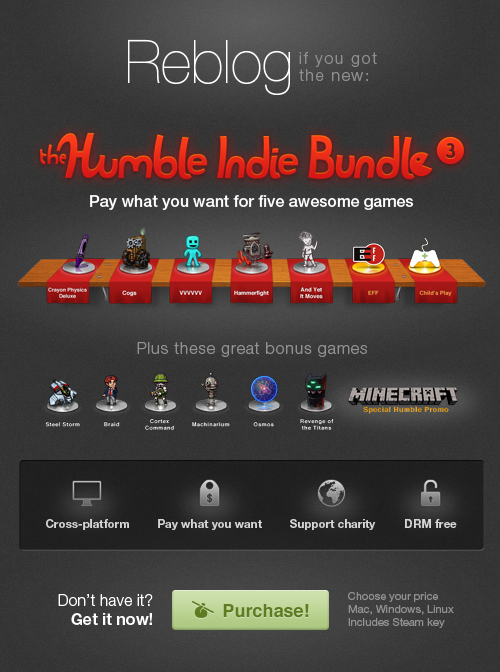What a little gem
Recently, when I bought the Humble Indie Bundle, I gained some free playtime on Minecraft. Not having played this before, I thought I'd finally give it a go. All I'd tried previously had been the predecessors and alternatives (Infiniminer, Manic Digger), so I thought I'd see why everyone was quietly addicted to this little game. Not even out of beta yet (supposedly being released some time in November 2011), it still manages to pull in the buyers with over three million purchases to date. That's not even including the people that are somehow managing to run it for free.
The basis of the game? You interact with a world of blocks (of various styles, but all the same shape), cacti, clouds, trees, snow, rain, lava, water, animals, mushrooms (two types), grass, flowers and of course, enemies (called mobs in the game). Most of the time when you kill an enemy—assuming they don't kill you first—you will end up with something else you can use. Skeletons drop their arrows and their bones, which you can then use to tame wolves with. Spiders will drop string, from which you can make fishing rods, bows and wool. Pigs give you pork chops that you can then eat, though you have to cook these to give you better health. Sheep also give you wool, that you can combine with colours to give you coloured wool. You can gain these colours by picking red or yellow flowers, or mining blue lapis lazuli gems. Pumpkins help make bright lights when you combine them with a light you made earlier out of a stick and a lump of coal. With stone, you can make furnaces where you can melt stuff and turn iron ore into iron ingots, or cook food, increasing its health value.
A builders nightmare
Out of this small collection of blocks (three types of wood, cobblestone, stone, dirt, wet dirt, water, lava, snow, flowers, coloured wool, etc etc), it's surprising what people have managed to make. Someone made a decent model of what they thought Hogwarts looks like inside, and even managed to add a little challenge to it—find all 100 diamonds. Others made worlds available where people can cooperatively build things, or challenge each other in PvP.
I've spent most of my computer time since installing just building my own little empire, surviving—or occasionally not—against the hordes of mobs that come out to kill you, and building the most weird constructions…a skywalk between two homes in the most recent world is my latest effort. I intend to grab enough sand to turn into glass to entirely encase the walkway in glass, and be safe from mobs as I walk between the two homes at night.
Minecraft wouldn't be minecraft without the ability to mine. So underground, you can also find coal, diamond, iron ore, redstone ore, gravel, and obsidian. With obsidian, you get to make…the Portal to the Nether.
The what?
The Nether is a completely different world, with lots and lots and lots of lava, and an enemy you really want to dodge the first time. Take a flint and steel when you go there, because you won't come back otherwise. I got caught in the Nether when a ghast extinguished the portal, and I had no way back. Since then, I've learned to keep out of their line of fire, and to protect the portal with big walls that they can't shoot through—cobblestone from the "real" world works best, though netherrack will do at a pinch. The Nether wouldn't be very much fun if you couldn't mine here, but at the moment, there's not much you can mine except for…well, lava. And you can pick that up in a bucket. Then there's netherrack, that you never seen in the real world. And glowstones, that you can make other bright lights with. Funnily enough, they even have gravel in the Nether too. And mushrooms.
So what's the draw? Why are so many people addicted?
I wish I knew how to answer that, I really do. All I know is—since I started, I find it hard to stop. And I guess that's the mark of a really good game. Yes, of course it's simple. The physics don't work like the real world, or else my skywalk would fall out of the sky. Trying to protect wolves from their own stupidity is sometimes more of a challenge than actually avoiding the enemies to begin with, but more fun sometimes, as you can walk into a collection of enemies with a little less regard for your life. The graphics are deliberately simplified, which makes for some odd looks when you're building stuff out of blocks that look like coloured lego stuck together. Oh, and don't get caught by a creeper. Those guys will kill you when they explode.
People have of course tried to modify the game so that you can use better graphics (photorealistic-ish blocks, trees, water, stones etc), and I've had mixed success with those. They sort of work, but then they slow the game down beyond what a good speed of reaction will provide. Other modifications are just plain useful, and there are a whole lot of these modifications. Currently they're all unsupported, but there will apparently be support for mods in the official client soon. I have to admit I rather like my minimap up in the right-hand corner.
Anyhow, I'm off to go glass in that walkway. Oh no, there's a creeper !!!!




